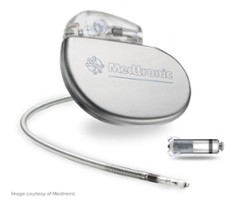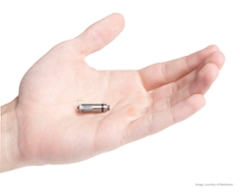World's Smallest, FDA-Approved Pacemaker
Almost all pacemakers use wires to send electrical signals that help your heart beat normally. Most patients will never experience problems or complications from these life-saving devices.
But for a small number of patients, wires can cause infections, blood clots, and pain in the delicate tissues around your heart.
University of Utah Health is offering a new leadless pacemaker, the world’s smallest and only FDA-approved pacemaker that doesn’t use leads—or wires—to send electrical signals into your heart.
Bringing Expert Care to You
Our cardiovascular specialist is the only surgeon in the Mountain West who is certified to implant the leadless pacemaker.
University of Utah Hospital is the only hospital in the region offering the leadless pacemaker to patients.
Find a Cardiovascular Specialist
Benefits of a Leadless Pacemaker
Unlike traditional pacemakers, the leadless pacemaker doesn’t use wires or need to be placed under your skin through a surgical “pocket.” Because of this, you have a lower chance of infection.
A leadless pacemaker lowers your chance of:
- infection,
- blood clots, and
- pain.
No Pocket
Since surgeons don’t need to cut underneath the skin around your collarbone to create a surgical “pocket,” you will also recover from surgery faster.
Other benefits include:
- small size,
- no scars or bulge under your skin,
- a lower chance of bleeding, infection, and the pacemaker migrating (moving) or poking through your skin, and
- no limits on your arm motions for the first 3-4 weeks after your surgery.
You will also have a lower chance of damaging your heart valve since surgeons do not have to create a pocket to insert the leadless pacemaker.

Privacy & Small Size
One of the most significant benefits of a leadless pacemaker is privacy. The only people who will know you have a pacemaker are you and your doctor. Traditional pacemaker vs. leadless pacemaker
The leadless pacemaker is also very small, about the size of a large vitamin. This small size allows the leadless pacemaker to be implanted directly inside your heart, so others won’t see the pacemaker inside your body.
Long-Lasting Battery
The pacemaker’s battery lasts for about 12 years—longer than most pacemakers. It also will not interfere with MRIs you may need.
What Will My Surgery Be Like?
Doctors will use a catheter to guide the pacemaker directly into your heart. The device will then attach onto your heart’s muscles. Your recovery time will be shorter than with traditional pacemakers.
If needed, doctors can also remove the pacemaker from your body. However, the leadless pacemaker is designed to be left in your body for many years.
Am I Eligible?
If your heart needs electrical stimulation in more than one place—for example, if the pacemaker you have now uses two or three leads—the leadless pacemaker is probably not the best option for you.
Talk to your doctor if you’d like to find out if the leadless pacemaker could help your heart condition.

